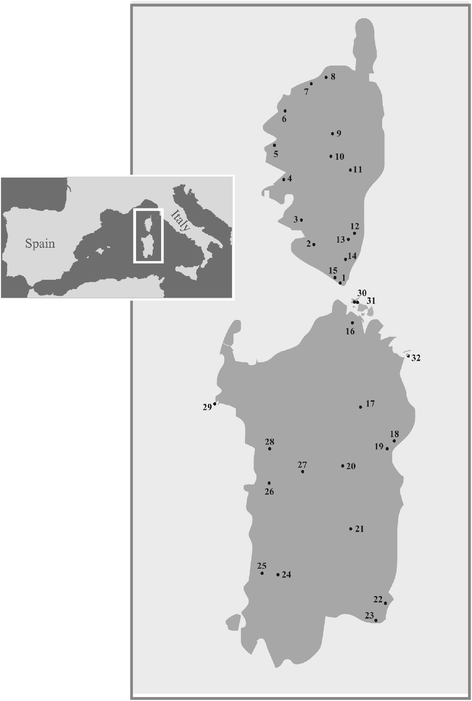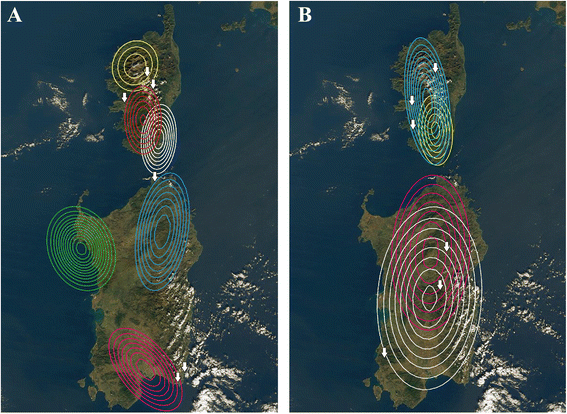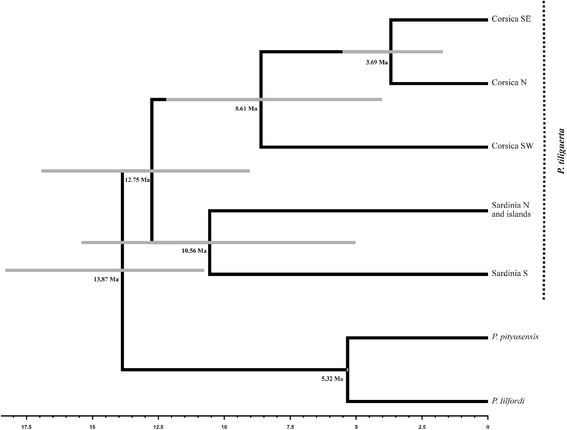Evolutionary history of Podarcis tiliguerta on Corsica and Sardinia
- PMID: 28103805
- PMCID: PMC5248522
- DOI: 10.1186/s12862-016-0860-4
Evolutionary history of Podarcis tiliguerta on Corsica and Sardinia
Abstract
Background: Podarcis tiliguerta is a wall lizard endemic to the Mediterranean islands of Corsica and Sardinia. Previous findings of high mtDNA and morphological diversity have led to the suggestion that it may represent a species complex. Here, we analysed mitochondrial and nuclear markers (mtDNA, 3110 bp; 6 nDNA loci, 3961 bp) in P. tiliguerta sampled from thirty-two localities across Corsica and Sardinia.
Results: We find much greater intraspecific genetic divergence than between sister species of other Mediterranean island Podarcis, i.e., between P. lilfordi and P. pityusensis. We detected three mtDNA clusters in Corsica (North, South-East and South-West) and either two or three in Sardinia (North vs. South) depending on the clustering method. Only one or two nDNA groups were identified within each main island (again, depending on the method). A Bayesian time-calibrated multispecies coalescent tree was obtained from mtDNA and provided statistical support for a Miocene origin of the species (13.87 Ma, 95% HPD: 18.30-10.77 Ma). The posterior mean divergence time for the Corsican and Sardinian lineages was 12.75 Ma ago (95% HPD: 16.94-9.04 Ma).
Conclusion: The results support the evolutionary distinctiveness of Corsican and Sardinian populations and also indicate a lack of post-divergence migration despite periods of contact being possible. Further to this, species delimitation analyses of Corsican and Sardinian lineages provided statistical support for their recognition as distinct (sister) taxa. Our results provide new insights into the biogeography of the Mediterranean biodiversity hotspot, and contribute important findings relevant to the systematics and evolution of this speciose lizard genus.
Keywords: Corsica and Sardinia Islands; Lacertidae; Mitochondrial DNA; Nuclear DNA; Podarcis tiliguerta; Species tree.
Figures





Similar articles
-
Digging up the roots of an insular hotspot of genetic diversity: decoupled mito-nuclear histories in the evolution of the Corsican-Sardinian endemic lizard Podarcis tiliguerta.BMC Evol Biol. 2017 Mar 2;17(1):63. doi: 10.1186/s12862-017-0899-x. BMC Evol Biol. 2017. PMID: 28253846 Free PMC article.
-
Multilocus genetic diversity and historical biogeography of the endemic wall lizard from Ibiza and Formentera, Podarcis pityusensis (Squamata: Lacertidae).Mol Ecol. 2013 Oct;22(19):4829-41. doi: 10.1111/mec.12443. Epub 2013 Aug 21. Mol Ecol. 2013. PMID: 23962158
-
Mitochondrial phylogeography of the Bedriaga's rock lizard, Archaeolacerta bedriagae (Reptilia: Lacertidae) endemic to Corsica and Sardinia.Mol Phylogenet Evol. 2010 Aug;56(2):690-7. doi: 10.1016/j.ympev.2010.03.017. Epub 2010 Mar 17. Mol Phylogenet Evol. 2010. PMID: 20302956
-
Genetic history of some western Mediterranean human isolates through mtDNA HVR1 polymorphisms.J Hum Genet. 2006;51(1):9-14. doi: 10.1007/s10038-005-0324-y. Epub 2005 Nov 24. J Hum Genet. 2006. PMID: 16307178 Review.
-
Hidden diversity within the lizard genus Liolaemus: Genetic vs morphological divergence in the L. rothi complex (Squamata:Liolaeminae).Mol Phylogenet Evol. 2017 Feb;107:56-63. doi: 10.1016/j.ympev.2016.09.009. Epub 2016 Sep 13. Mol Phylogenet Evol. 2017. PMID: 27637991 Review.
Cited by
-
The Intriguing Biogeographic Pattern of the Italian Wall Lizard Podarcis siculus (Squamata: Lacertidae) in the Tuscan Archipelago Reveals the Existence of a New Ancient Insular Clade.Animals (Basel). 2023 Jan 23;13(3):386. doi: 10.3390/ani13030386. Animals (Basel). 2023. PMID: 36766275 Free PMC article.
-
Range-Wide Phylogeography and Ecological Niche Modeling Provide Insights into the Evolutionary History of the Mongolian Racerunner (Eremias argus) in Northeast Asia.Animals (Basel). 2024 Apr 7;14(7):1124. doi: 10.3390/ani14071124. Animals (Basel). 2024. PMID: 38612363 Free PMC article.
-
Reproductive Traits and Hatchling Characteristics of the Endemic Sardinian Grass Snake (Natrix helvetica cetti): First Field Data, with Screening for Ophidiomyces ophidiicola.Animals (Basel). 2025 Feb 3;15(3):418. doi: 10.3390/ani15030418. Animals (Basel). 2025. PMID: 39943188 Free PMC article.
References
-
- Rosenzweig ML. Species diversity in space and time. Cambridge: University Press; 1995
-
- Fernández-Palacios JM. Why islands. Islands Evolution. 2010;85–109.
-
- Verlaque R, Médail F, Quézel P, Babinot J-F. Endémisme végétal et paléogéographie dans le bassin méditerranéen. Geobios. 1997;30:159–166. doi: 10.1016/S0016-6995(97)80083-6. - DOI
-
- Médail F, Quézel P. Biodiversity Hotspots in the Mediterranean Basin: Setting Global Conservation Priorities. Conserv Biol. 1999;13(6):1510–1513. doi: 10.1046/j.1523-1739.1999.98467.x. - DOI
MeSH terms
Substances
LinkOut - more resources
Full Text Sources
Other Literature Sources

